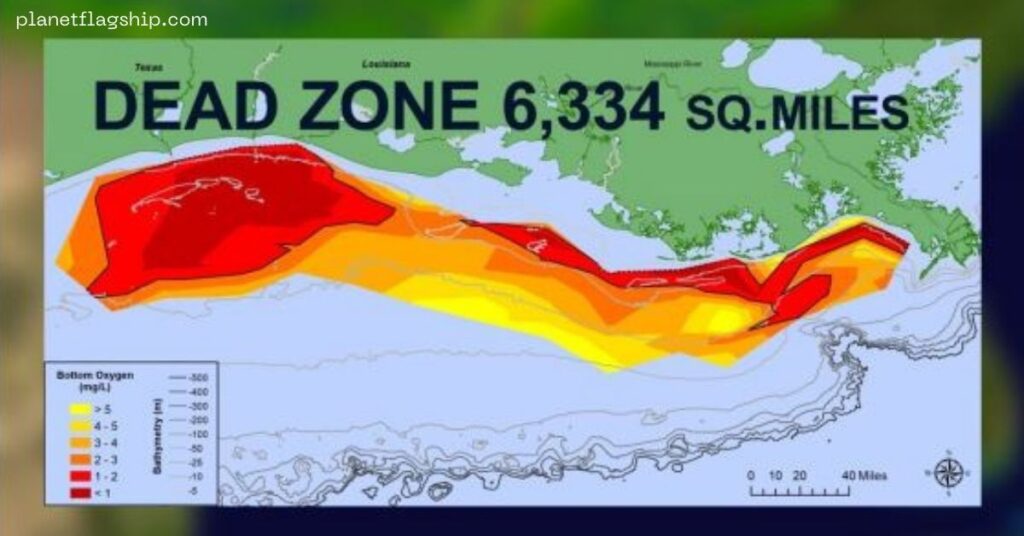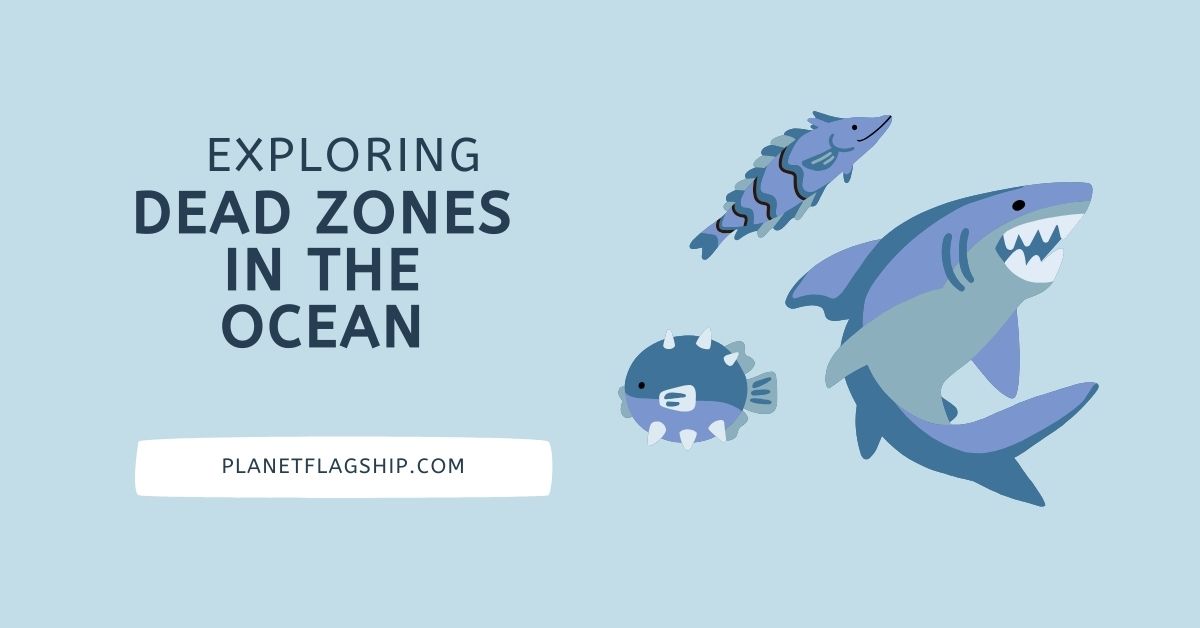INTRODUCTION
A significant environmental concern strongly linked to climate change is the emergence of Dead Zones in the Ocean, which pose substantial risks to both human livelihoods and marine ecosystems. Fish, crabs, and other aquatic life die in large numbers in dead zones, which are regions of ocean and coastal waters where oxygen levels are so low that most marine life cannot survive.
Due to a combination of nutrient pollution and warmer ocean temperatures resulting from human-induced climate change, the number and magnitude of dead zones have increased significantly in recent decades. Protecting the health of the ocean and the communities that depend on it requires an understanding of the origins, effects, and potential hazards connected with dead zones.
To address this growing concern, this article will examine how climate change exacerbates the creation and expansion of dead zones, the resulting ecological and economic impacts, and the urgent need for sustainable practices.
The Formation and Expansion of Dead Zones

What are Dead Zones?
Dead zones, sometimes referred to as hypoxic zones, are areas of marine habitats where the dissolved oxygen content falls below 2 mg/L, which is too low to sustain most marine life. These areas frequently form in coastal seas where large algal blooms are caused by nutrient runoff from sewage, industrial, and agricultural sources. The oxygen in the water is depleted as algae die and break down, resulting in hypoxic conditions that can persist for weeks or months and harm marine ecosystems.
The Role of Nutrient Pollution:
Nutrient contamination, especially nitrogen and phosphorus compounds that enter streams from fertilizers, animal waste, and sewage, is the main cause of dead zones. As a result of this nutrient enrichment, algae and phytoplankton develop rapidly until they die and sink, leading to oxygen depletion during their decomposition. Due to nitrogen runoff from the vast agricultural fields of the Mississippi watershed, the Mississippi River/Gulf of Mexico dead zone, one of the largest in the world, spans hundreds of square miles every summer.
READ MORE: How Youth Activists Are Leading the Fight for Climate Change?
Climate Change as an Aggravating Factor
Climate change is expanding into dead zones through several interrelated mechanisms.
Ocean Warming
Warmer waters hold less dissolved oxygen because rising sea surface and deeper ocean temperatures make oxygen less soluble in water. Ocean temperatures reached historic highs in 2024, continuing a worldwide warming trend driven by increasing greenhouse gas emissions. Due to this warming, the metabolic rates of marine creatures increase, thereby increasing their demand for oxygen at a time when the oxygen supply is decreasing.
Stratification
Because they are warmer, rising surface waters are less likely to mix with deeper, oxygen-rich waters. Dead zones can continue to grow because of this stratification’s ability to retain oxygen-poor water near the seafloor.
Increased Runoff and Algal Bloom
Changes in precipitation patterns brought about by climate change often result in increased rainfall events, which in turn raise the amount of nutrients that wash into coastal seas. Algal blooms and the ensuing oxygen deprivation are made worse by this.
Sea Level Rise and Acidification
While ocean acidification damages marine life and may reduce ecosystem resistance to hypoxia, rising sea levels can alter coastal circulation and habitats.
According to research, 94% of the world’s dead zones are found in areas predicted to warm by at least 2°C by the end of this century, indicating that climate change will greatly exacerbate the dead zone issue worldwide.
Ecological and Economic Impacts of Dead Zones:

Effects on Marine Life and Ecosystems:
Dead zones disrupt food webs and reduce biodiversity by causing widespread mortality of fish, shellfish, and benthic organisms. Mobility-capable species may escape hypoxic regions, leading to habitat compression and increased competition. By encouraging resistant species and reducing ecological productivity, persistent dead zones can alter the structure of communities.
Impacts on Fisheries and Local Communities
Commercial and recreational fisheries are impacted by the loss of marine life in dead zones, endangering livelihoods and food security. For instance, the dead zone in the Gulf of Mexico has a detrimental effect on fish and shrimp populations, resulting in financial losses for coastal fisheries. Furthermore, tourism and public health may be negatively impacted by fish kills and toxic algal blooms connected to nutrient pollution and hypoxia.
Feedback Loops and Long-term Risks
Feedback loops produced by dead zones have the potential to worsen marine habitats. Decomposing algal blooms contribute to climate change by releasing greenhouse gases, including nitrous oxide. Hypoxia and nutrient accumulation may worsen if seabed creatures that recycle nutrients disappear. Dead zones may expand in size, frequency, and duration if no action is taken, potentially leading to ecosystem collapse in certain areas.
Solutions and Sustainable Practices
Reducing Nutrient Pollution
Controlling nutrient inputs through enhanced farming techniques, including the use of cover crops, buffer zones to reduce runoff, and precise fertilization, is necessary to mitigate dead zones. Limiting nutrient loads entering coastal waters can also be achieved by improving stormwater management and wastewater treatment.
Climate Change Mitigation and Adaptation
Greenhouse gas emissions are the primary cause of ocean warming, and they must be addressed. The effects of climate change on oceans can be mitigated by switching to renewable energy, improving carbon sinks, and implementing sustainable land-use practices. Restoring wetlands and seagrasses is one coastal management technique that can raise oxygen and water quality.
Monitoring and Research
Using technologies such as satellite data and in situ sensors, along with ongoing scientific monitoring of dead zones, helps track changes and assess the effectiveness of remedial measures. Adaptive management and policy decisions are informed by research on the intricate relationship between hypoxia and climate change.
Public Awareness and Policy Action
Increasing public awareness of dead zones and their connection to climate change can help secure financing for restoration programs and policy support for environmental regulations. To implement successful solutions, cooperation among governments, scientists, farmers, and communities is essential.
FAQ’s
What are ocean dead zones and why do they form?
Dead zones are areas in the ocean where oxygen levels drop so low that most marine life cannot survive. They form mainly due to nutrient pollution from fertilizers, sewage, and industrial waste. As algae die and decompose, they use up oxygen, leaving waters hypoxic.
How does climate change worsen dead zones?
Climate change warms ocean waters, reducing their oxygen capacity. Rising sea levels, stronger rainfall, and altered circulation patterns increase nutrient runoff and algal blooms. These combined effects make dead zones larger, more frequent, and longer lasting.
What are the ecological impacts of dead zones?
Dead zones disrupt food webs, kill fish and shellfish, and shrink habitats. Species that can move flee to safer areas, creating overcrowding and competition. Long-lasting dead zones weaken biodiversity and damage marine ecosystems permanently.
How do dead zones affect people and economies?
Dead zones reduce fish stocks, harming commercial and local fisheries. Coastal communities lose jobs, face food insecurity, and see declines in tourism. Public health can also be affected when toxic algal blooms contaminate seafood and water.
What solutions exist to reduce dead zones?
Key solutions include cutting nutrient pollution through better farming, wastewater treatment, and stormwater control. Restoring wetlands and seagrasses improves oxygen levels. Global efforts to reduce greenhouse gas emissions also help limit ocean warming and hypoxia.
CONCLUSION
The emergence of dead zones in the world’s oceans is a clear sign of the interconnected problems of climate change and nutrient pollution. Through rising waters, altered precipitation patterns, and ocean stratification, climate change is intensifying and expanding these oxygen-depleted zones, endangering fisheries, marine biodiversity, and coastal economies. To prevent climate change, restore coastal ecosystems, and reduce nutrient runoff, immediate action is required to address this challenge. Important first steps include enhanced wastewater treatment, sustainable farming methods, and international initiatives to reduce greenhouse gas emissions.
To preserve ocean health, policy must be informed by thorough scientific research and public involvement. By taking these steps, we can safeguard food security, protect marine species, and maintain resilient ocean ecosystems in the face of global warming.
This assignment provides a fact-based and current perspective on the expansion of dead zones and their relationship to climate change, drawing on recent scientific discoveries and authoritative reports from NOAA, the Smithsonian Environmental Research Center, and climate studies published through 2024 and 2025.
REFERENCES
National Centers for Coastal Ocean Science. (2023, August 2). Below average summer 2023 ‘Dead zone’ measured in Gulf of Mexico – NCCOS – National Centers for Coastal Ocean Science. NCCOS – National Centers for Coastal Ocean Science. https://coastalscience.noaa.gov/news/below-average-summer-2023-dead-zone-measured-in-gulf-of-mexico/
Ocean temperatures reach record high in 2024, aggravating extreme weather events. (n.d.). https://carbonimpacts.info/article/ocean-temperatures-reach-record-high-in-2024-aggravating-extreme-weather-events–678a989e33354
Dead zones. (n.d.). Virginia Institute of Marine Science. https://www.vims.edu/research/topics/dead_zones/
Climate change likely to worsen U.S. and global dead zones. (2015, February 2). NOAA Climate.gov. https://www.climate.gov/news-features/featured-images/climate-change-likely-worsen-us-and-global-dead-zones

John is a professional blogger and passionate advocate for environmental sustainability. With years of experience exploring eco-friendly practices and green innovations, he shares insightful articles on Planet Flagship to inspire a sustainable future. John’s expertise lies in making complex environmental topics accessible and actionable, empowering readers to make meaningful changes for the planet.
